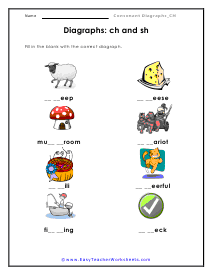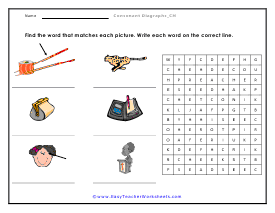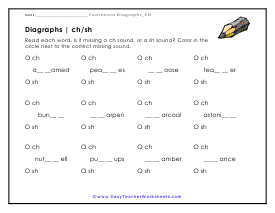When you have two unique consonants that together have a single sound that chunk of consonants is referred to as a "consonant diagraph". The most common starting diagraphs are sh, ch, wh, and th. These diagraphs are often referred to as the "h brothers". You will find these to be the most common jump off points for students in preschool or kindergarten. I always like to start with "sh" by shutting out the lights and saying, well you can guess where I am going with this. The worksheets below focus on using and applying the ch consonant diagraph in wide range of situations. This will help you understand and use terms that include the ch diagraph. The most common words formed by this diagraph are- suffixes: each, pitch, rich, lunch, and such. prefixes: chair, chin, chip, child, and cheek.
Print ch Consonant Digraphs Worksheets
Click the buttons to print each worksheet and associated answer key.

Word Fills
Say the sound that this pair of letters makes: ch Now look at the pictures, and fill in the missing letters.

Identification of ch Diagraph
Circle the word that names the picture then write the term that best completes each sentence.

Say It, Name It
A diagraph is two letters that make a single sound. Say the name of each picture. Then write its name on the line.


Diagraphs: ch and sh
Fill in the blank with the correct diagraph. We will work with differentiating between two of them.


Which Diagraph?
Choose the correct letters to complete each of the words. The best way to approach each problem is to sound it out.


Those Two Things
Can you think of two things whose name contains the diagraph ch? Draw a picture of each thing. Then write its name on the line.

Scissors and Glue
Say the name of each picture. Cut and glue the correct blend to complete each word.


Sentence Bubbles
Say the name of each picture out loud. If you here the diagraph ch at the beginning of the word, color the dot before the picture. If you hear the diagraph ch at the end of the word, color the dot after the picture. If you hear ch at both ends, color both dots.

Sentence Circles
Look at the pictures, and fill in the missing letters. Circle the word that has the same ending sound as the first one.

Bubble Me Plain
Diagraphs found at the beginning or end of the word. Mark the circle that indicates the position where this occurs.

Diagraphs | ch/sh
Read each word. Is it missing a ch sound, or a sh sound? Color in the circle next to the correct missing sound.
What Are Ch Consonant Digraphs?
When two consonants join together to make a single sound, they are called consonant digraphs. Some common consonant digraphs are ch-, sh-, th-, ph-, and wh-. If you say the word chin, you can hear that ch makes one sound /ch/. The digraph ch- can come either at the beginning or at the end of words.
Here are a few examples of the ch- digraph in the beginning:
- Chair, chain, children, chalk, cheap, check, cheer, cheese, chat, chase, chop, choose, chip, child, chick, chew, chest, cherry, chapter, choice, church
Here's a list of words ending with the ch- digraph:
- Reach, which, breach, beach, bench, branch, catch, hatch, couch, coach, lunch, march, match, touch, switch, stretch, speech, ranch, pitch, patch, much
Teaching How to Make Words with the ch- Digraph
The ch- digraph can be introduced to the kids using a myriad of activities. We're discussing a few that are equally liked by teachers and the kids.
1. Draw the Words
Kids who have difficulty in letter formation and writing particularly enjoy this activity. Read any of the ch- words, for example, beach, and ask the kids to draw it. The visual representation will help them learn the digraph and the corresponding images. You can also make the kids write a few words and help them match the words with their accurate pictures.
2. Jumbled Sentences
Think of easy and small sentences, such as take a peach, this is my chair, crush the rock, etc. Start by writing these on the board so the kids can see how you've formed the letters and written the full sentences. After they've read the sentences, clear the board ,and write the sentences again but in the wrong order. Jumble the words in each sentence and ask them to copy them in their worksheets or notebooks by writing them in the correct order.
A Sample Lesson:
This lesson is designed for students of kindergarten or grade 1 who have already learned the consonant and vowel sounds and are now ready to progress to the consonant digraphs.
1. Start with the Introduction
Script for the teacher: We have learned the sound of all letters and we also know how to join these sounds to form a word. Let's see this word and read it together.
Write the word "mat." Ask the students to sound each letter, pausing slightly in between each: /m/ /ă/ /t/. Then, blend the sounds together and say the word: "m-a-t." Lastly, quickly blend the sounds to say the word: "mat."
You remember how to use the letter-sounds for reading and spelling words! Today, we are learning something new. Some letters make special sounds when they join together. Sometimes, two letters come together and instead of making their own two sounds, they make only one sound!
2. Explain the Concept
Script for the teacher: When two consonants join and make only one sound, they are called a digraph. Repeat after me: digraph. Let's say it again: digraph. Now, let's see what a digraph looks like.
Letters c and h have made this digraph but, when you see them together, you won't sound them out as /c/ /k/. Instead, you will call them by a special sound /ch/. Repeat after me: /ch/. One more time: /ch/. (Show them a pack of chips drawn on the whiteboard or a chart.) We will remember the ch- digraph by this picture. Who can tell me what is this?
Students: Chips.
Script for the teacher: Very good! Do you see the word written under the picture? The word is "chip." Do you see the digraph ch at the beginning of this word? How will we pronounce it? /ch/ Chip starts from which sound?
Students: /ch/
Revise from the beginning with a new word for complete understanding.



